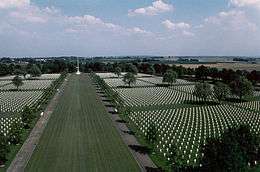Netherlands American Cemetery
Netherlands American Cemetery and Memorial (Dutch: Amerikaanse Begraafplaats Margraten) is a Second World War military war grave cemetery, located in the village of Margraten, 10 km (6.2 mi) east of Maastricht, in the most southern part of the Netherlands. The cemetery, the only American one in the Netherlands and dedicated in 1960, contains 8,291 American war dead and covers 65.5 acres (26.5 ha). It is administered by the American Battle Monuments Commission.[1]
| Netherlands American Cemetery and Memorial | |
|---|---|
| American Battle Monuments Commission | |
 Netherlands American Cemetery | |
| Used for those deceased 1941–1945 | |
| Location | 50°49′N 5°48′E near |
| Total burials | 8,291 |
| Burials by nation | |
* United States:8,291 | |
| Burials by war | |
* World War II: 8,291 | |
| Statistics source: American Battle Monuments Commission | |
History
The cemetery was created in November 1944 under the leadership of Joseph Shomon of the 611th Graves Registration Company, as the Ninth United States Army pushed into the Netherlands from France and Belgium. American casualties from the area, and also those that fell in Germany were buried here (as Americans could not be buried permanently in enemy territory). Within six months more than 10,000 American casualties were interred at the cemetery.
In the late 1940s the Americans started exhuming, repatriating and reburying fallen US service personnel from across the Netherlands. Over half the American dead were repatriated to the US with the rest re-interred in the expanded Margraten cemetery. Nearly all US personnel were concentrated at the cemetery with the exception of some burials at Zoetermeer (pilot John E. McCormick), Loosdrecht (Jasper Vandenbergh killed in action 16 December 1944 at St. Vith - originally interred at Henri-Chappelle but moved to Loosdrecht cemetery at the request of his parents who both came from the town) and Opijnen (eight of the crew of B-17 Man-O-War shot down over Opijnen on 30 July 1943).
Over 3,000 German that had been buried in a field adjacent to the American one were reburied at Ysselsteyn German war cemetery. Russian soldiers were moved to Amersfoort. Additionally, a thousand Commonwealth soldiers, mainly British and Canadian, were also moved to cemeteries elsewhere post war.
The cemetery was dedicated in 1960 and officially opened by Queen Juliana of the Netherlands.
Architecture and layout
The cemetery covers 26.5 hectares (65.5 acres) and from the entrance there is Court of Honor with a reflecting pool. There is a visitors' building and a museum with three engraved operations maps designed by Yale University graduate Lewis York (who is buried in Akron, Ohio) and executed by the Dura Company of Heerlen, Holland, describing the movements of the American forces in the area during World War II.[2] At the base of the chapel tower, facing the reflecting pool, is a statue by Joseph Kiselewski representing the grieving mother for her lost son.
The walls on either side of the Court of Honor contain the Tablets of the Missing on which are recorded the names of 1,722 American missing service personnel; rosettes placed to a name denote that the person has since being identified. Beyond the chapel and tower is the burial area which is divided into sixteen plots. 8,291 American dead, most of whom fell close to the cemetery, are interred in the cemetery with headstones set in long curves.
Annual commemorations
Each year on the Dutch Memorial Day commemorations take place in the cemetery. In 2005, President George W. Bush became the first American president to visit the cemetery. The following quote is from a speech President Bush gave that day:
On this peaceful May morning we commemorate a great victory for liberty, and the thousands of white marble crosses and Stars of David underscore the terrible price we pay for that victory. For the Americans who rest here, Dutch soil provides a fitting home. It was from a Dutch port that many of our pilgrim fathers first sailed for America. It was a Dutch port that gave the American flag its first gun salute. It was the Dutch who became one of the first foreign nations to recognize the independence of the new United States of America. And when American soldiers returned to this continent to fight for freedom, they were led by a President (Roosevelt) who owed his family name to this great land.
Notable burials
- Lt. Col. Robert G. Cole, United States Army – Medal of Honor
- Pfc. Willy F. James, Jr., United States Army – Medal of Honor
- Pvt. George J. Peters, United States Army – Medal of Honor
- S/Sgt. George Peterson, United States Army – Medal of Honor
- Maj. Gen. Maurice Rose, United States Army – Highest ranking soldier killed by enemy fire in the European Theater
- Pfc. Walter C. Wetzel, United States Army – Medal of Honor
- 1st Lt. Walter J. Will, United States Army – Medal of Honor
References
- American Battle Monuments Commission. "Netherlands American Cemetery". abmc.gov. Retrieved 22 February 2019.
- Nishiura, Elizabeth, editor, American Battle Monuments: A guide to military cemeteries and monuments maintained by the American Battle Monuments Commission, Omnigraphics, Inc., Detroit, Michigan, 1989
Further reading
- Sledge, Michael (2005). Soldier Dead: How We Recover, Identify, Bury, and Honor Our Military Fallen. New York: Columbia University Press. ISBN 9780231509374. OCLC 60527603.
- Schrijvers, Peter (2012). The Margraten Boys How a European Village Kept America's Liberators Alive. London: Palgrave MacMillan. ISBN 9780230346635